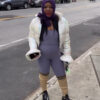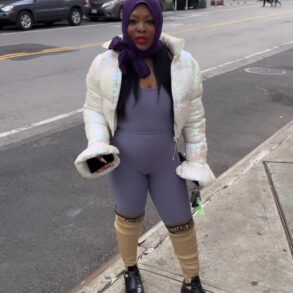
AG Club, WE’RE ALL BRODIES* (TheNamelessCollective/Epic/Sony)
We spent 2023 waxing philosophical about hip-hop’s 50th anniversary, so AG Club’s whimsical, chaotic-good rap feels like a needed push forward. The Gen Z collective from the East Bay suburbs of Oakley and Antioch had a huge year performing at Coachella and Camp Flog Gnaw, and their EP WE’RE ALL BRODIES* stands out amid their string of short releases. Opening with the off-kilter, woozy “eva,” rappers Jody Fontaine and Baby Boy trade verses with the energy of two class clowns egging each other on. The swag-rap track “Barry” punctuates a carnivalesque piano loop with earth-rattling bass prime for a mosh pit. “CAJH DAY*” charms with its playfulness: “Monteezy Street with a kitty name Tucker / Slidin’ in a Ford Focus, dimple in the bumper,” raps Jody. The song includes a punchy homage to Keak Da Sneak, but in general, AG Club sound unconcerned with pigeonholing themselves into a regional sound, instead creating something omnivorous and expansive. — Nastia Voynovskaya
B. Hamilton, ‘Other Lives of Magic and Wonder and Whatever’ (Self-released)
Oakland’s B. Hamilton has been a staple of the Bay Area’s garage rock scene for over a decade now, but 2023 found the band reintroducing itself as a duo — and a productive one at that. Singer-guitarist Ryan Christopher Parks and drummer Raj Ojha put out three tight, listenable EPs this year, each packed with blues, psychedelia, indie-pop, post-punk, folk and surf-y flavors. The constant is Parks’ lyrical specialty: cinematic storytelling that’s also light on its feet, deeply felt without taking itself too seriously.
Other Lives of Magic and Wonder and Whatever, in particular, does a lot in 17 minutes, kicking off with the sweetly propulsive, slide-guitar sigh of “Don’t Ever Hide Your Face.” But “I Bought a Lottery Ticket” is the track that hooked me back in July: “Tomorrow I’ll be a trillionaire, and none of this will matter much / I bought a lottery ticket on the way home from church, and man I feel lucky as fuck,” proclaims Parks, calling to mind Stephen Malkmus at his driest. It’s a summery blend of late-capitalist fantasy and nihilism, all swirled into one wry, rock ‘n’ roll soft-serve cone. — Emma Silvers
DJ.Fresh, ‘The Tonite Show’ (Fresh in the Flesh/BMG)
Producer DJ.Fresh has perfected his recipe of soulful samples, ’80s-style synths and drums that kick like judo students. After nearly two decades of spotlighting rapper after rapper on his Tonite Show album series, Fresh consulted his extensive network for The Tonite Show album, which positions him as a super-producer with reach far beyond the Bay.
The Tonite Show features notable artists from different regions and hip-hop generations, but it’s clearly Bay Area first. The song “What’s That All About” showcases the lyrical gas and unmistakable laugh of North Vallejo’s LaRussell. On “Doin’ Too Much,” Richmond’s Jane Handcock slides over drums that sound like the finale of a firework show. And the album’s lead single, “Pop My Shit,” (featuring E-40, Larry June and Dreebo) should be considered when you’re compiling the region’s best hip-hop songs of the year.
— Pendarvis Harshaw
Frightwig, ‘We Need to Talk’ (Label 51 Recordings)
Back in 1983, Deanna Mitchell and Mia d’Bruzzi were just a couple of creative teens running amok in San Francisco’s vibrant, underground punk scene. Realizing they had something — well, a lot — to say, they formed Frightwig, a pre-riot grrrl rallying cry to the furious and disaffected women of America. Long acknowledged as influential to bands like Hole, L7 and Babes in Toyland among many others, the band’s decision to reform this year was a nice surprise. That the album that heralded Frightwig’s return succeeded in being caustic, clever and catchy was a legitimate thrill.
We Need to Talk consistently flings eye-rolls and middle fingers directly at bad men, misogynist policies, unchecked capitalism and even to aging itself. Delightfully, the 11-tracker is also imbued with smatterings of side winks and sharp humor. (And we’re not just talking about the fact that there’s a song here called “My Crotch Does Not Say Go.”) We Need to Talk is the unhinged, unfiltered, all-ages punk rock party we didn’t know we needed in 2023. A cathartic treat indeed. — Rae Alexandra
Goapele, ‘Colours’ (Sky Blaze Music)
At this point in her singing career, Goapele knows her lane. She’s still making music for her day-one fans, fully recognizing that they — and she — have matured. The eight songs that comprise Colours maintain a grown-folks sensibility; the album’s romantic longings are grounded in actualization and healthy communication. Every song is about relationships, whether with a significant other or oneself. There’s a poignant sense of awareness throughout, as the singer-songwriter serendipitously slays her soulful, jazz-tinged pocket. The sparse accompaniments smoothly set mellow moods for bedroom intimacy or long-walk companionship. Colours’ best song, “Time Heals,” revels in reflection without regret, and may trigger Anita Baker comparisons with its downtempo vibe. Elsewhere, there’s a love affair arc from the initial spark in “Ojai” to the questioning phase in “Complicated.” Yet Goapele never seems overwhelmed by the strong emotions she’s experiencing, offering hope for hopeless romantics. — Eric Arnold
La Doña, ‘Can’t Eat Clout’ (Text Me Records)
Instead of looping samples, La Doña did something rare for an up-and-coming musician in 2023: She assembled a 13-piece band for Can’t Eat Clout, an ambitious EP that shows her reaching a new level as a bandleader and political messenger. “Paloma No Vuelve Amar” and “Can’t Eat Clout” expertly mingle cumbia, salsa and dembow rhythms. A big, anthemic brass section and La Doña’s pirouetting vocals invite listeners to lose themselves on the dance floor. “Can’t Eat Clout” ends with a titular chant that may well be a protest against today’s paid-in-exposure music industry. That anti-capitalist commentary runs through “Show Me How You Livin’,” where a hyphy bass line and charismatic rap verse from Tia Nomore might make you catch the Furly Ghost. With Can’t Eat Clout, La Doña skillfully weaves traditions that span the Americas into her own distinctly Bay Area sound, and fills our hearts with fire to fight for a better world. — Nastia Voynovskaya
Larry June & The Alchemist, ‘The Great Escape’ (The Freeminded Records/ALC/EMPIRE)
A link up with The Alchemist — one of hip-hop’s most respected producers — and features from A-listers like Whiz Khalifa and Ty Dolla $ign make clear that Larry June has broken out of the Bay Area’s regional bubble and escaped to rap’s big leagues. The album whisks the listener away to other lands: Mexico City in the “Porsches in Spanish” music video, and a beachside resort on an alien planet courtesy of the slinking synths on “Palisades, CA.” So naturally, The Great Escape has propelled June to sold-out shows not just nationwide, but all across the globe.
Despite the new international reach, June’s raps remain rooted in the Bay (“Bend a corner, I’m on Hayes Street copping a windbreaker,” he raps on “Turkish Cotton”) and true to himself. He’s still delivering the same unique blend of healthy living, entrepreneurial acumen and fly decadence that fans have grown to love, and showering listeners with bars about multimillion-dollar real estate investments in Tiburon and chlorophyll-filled health potions. Good job, Larry! — Dario McCarty
Lil Kayla, ‘Who Is Lil Kayla?’ (Asylum Records)
The latest bold, take-no-shit project from San Francisco’s Lil Kayla may as well be titled The Girls’ Guide to Hustling Men 101. Raised in the Sunnydale projects, Kayla hands out seven tracks of free game: know your worth, get money, ignore time-wasters, don’t catch feelings. (Dua Lipa’s “New Rules” reads like The Cat in the Hat compared to Kayla’s “Rules,” which in one ruthless minute condenses a lifetime of hard-won lessons.) The production by OMG JAYE and UglyMarco adds just enough bass slump to keep it Bay Area, but with a recent major-label deal from Asylum Records, it’s clear that, for the rest of the world, Who Is Lil Kayla? won’t be a question for long. — Gabe Meline
Madeline Kenney, ‘A New Reality Mind’ (Self-released)
Most people might spend their time after a breakup on the phone with their friends, wrapped in a blanket on the couch — or, if we’re honest, stalking their ex’s Instagram. Oakland’s Madeline Kenney produced what’s undoubtedly her finest professional achievement to date: the drop-dead gorgeous A New Reality Mind, a mournful but powerful whirlwind of a record. After a 38-second intro, you’re dropped into a dream world where unearthly chirps, whirs and flutters are fashioned into angular and complex tunes — mysterious and intriguing enough to make you start the album over again as soon as it ends.
Contrary to previous guitar-based work, A New Reality Mind is produced almost entirely on synths, and they carry this album in a way that feels transporting and sublime. It’s hard to believe, as she’s got almost a decade of critical acclaim under her belt, but A New Reality Mind shows that somehow Madeline Kenney just keeps getting better and better. — Jody Amable
Maria BC, ‘Spike Field’ (Sacred Bones)
Maria BC named Spike Field after a proposed form of communication designed to be impossible to misinterpret: jagged spires erected at nuclear sites and other hazardous areas to warn away potential visitors from far-flung worlds or distant futures. This image suits the prickliness of the music on the Oakland singer-songwriter’s second album (and debut on the vaunted Sacred Bones label), whose delicate guitars and angelic vocal layers are under constant threat of being interrupted by bursts of harsh digital noise. It also speaks to the quality separating Maria BC from the legions of ambient folkies out there: a real sense of chops and rigor, a reliance on the strength of their voice and arrangements rather than studio trickery (even the echo on one song is just the artist overdubbing their voice twice). Music so ethereal rarely sounds so exact. — Daniel Bromfield
Myra Melford’s Fire And Water Quintet, ‘Hear the Light Singing’ (RogueArt)
Like one of her primary influences, Pulitzer Prize-winning alto saxophonist/composer Henry Threadgill, Berkeley pianist Myra Melford has a gift for assembling singular ensembles for which she devises arrestingly textured tunes. Her all-star Fire And Water Quintet is her latest band, and the all-women group features master improvisers who are also prolific bandleaders in their own right, including German saxophonist Ingrid Laubrock, drummer Lesley Mok and two MacArthur Fellows, cellist Tomeka Reid and guitarist Mary Halvorson. A companion piece to the group’s 2022 debut album, which was inspired by the enigmatic drawings of Cy Twombly, Hear the Light Singing features a cohesive body of tunes that refract Melford’s slow-dancing melodies inspired by the Mediterranean sunlight in Italy where Twombly created his graphics. Shimmering, surging and often dazzling, the interplay keeps shifting perspective as different players intertwine and shift then recede from the foreground. — Andrew Gilbert
Nappy Nina, ‘Mourning Due’ (LucidHaus)
Nappy Nina is known for her bars. Raised in Oakland and living in New York, she uses her clever cadences and smooth similes to make music for easy listening. But don’t write off Morning Due as simply headphone music. On the project Nina whispers word puzzles and peddles poetic phrases over shifty drum patterns, and the production moves from dream-like melodies to in-your-face blap. The track “Whippin’,” featuring lojii, is a banging single made for a late-night drive with windows down and volume up. On “Prayer Posture,” featuring JusMoni, Nina floats over a heavyweight bassline as she takes us into her spiritual side. And on “Sorrel Sip,” Nina showcases her ability to break words down, rhyming syllables and simultaneously referencing culturally relevant symbols. There’s layers to this album, and that’s what keeps her music in rotation. — Pendarvis Harshaw
Ryan Wong, ‘The New Country Sounds of Ryan Wong’ (Rocks In Your Head)
When it comes to country music from the Bay Area, there’s often a sense we’re cosplaying the cowboy lifestyle — what could we know about honky-tonk hoedowns and homes on the range out here in the land of $7 lattes? Ryan Wong, of San Francisco psych-rock outfit Cool Ghouls, struck out on his own again this year to create a country record that sounds damn close to the real thing. Trading the distant, breathy sounds of the Ghouls for some steel guitar, but never losing his mordant vocal delivery, The New Country Sounds of Ryan Wong combines hallmarks of the genre with a laid-back coastal cool. Produced by the consistently folky San Francisco musician Sonny Smith (the perfect choice to usher this album into existence), it’s all at once a wink, a nod and a tribute to a genre we may not have mastered, but can still make our own. — Jody Amable
Salami Rose Joe Louis, ‘Akousmatikous’ (Brainfeeder)
The post-apocalyptic sci-fi concept album has rarely been executed in a way that resonates not just with the current ills of the world, but also with the prevalent, ever-shifting sounds of pop culture. On Akousmatikous, Salami Rose Joe Louis’ Lindsay Olsen executes the feat in Deltron-like fashion, speaking to the barren wasteland that our fast-heating planet is destined to become at the hands of merciless politicians.
“Dimensional Collapse” feels like riding in a spaceship at light speed before landing on the deserted planet of “Always On My Mind.” Breakneck drum beats speed through wormholes of electro jazz keys that see the light in Olsen’s downright celestial vocals. By the time we arrive at the tricky bounce of “Propaganda,” featuring Brijean, we’re engrossed into the world that the Oaklander has created so masterfully. It’s a mysterious place, a beautiful one that yearns for harmony amid growing chaos. Is this the future, or the here and now? — Adrian Spinelli
Scary Scare, ‘First Fright’ (Self-released)
Before launching their fearsome, theatrical and frequently costumed horror-punk band Scary Scare, frontman James O’Shaughnessy and drummer Aaron Apple played in a pretty standard Cali-reggae band called Grooview. Their new, outrageous songs about smoking live ants and breaking into the haunted Palace Hotel might seem like a left turn — but slow Apple’s drums down to half tempo, keep everything else the same and a lot of the music on their debut First Fright turns out to be pretty close to reggae after all. Rather than obliterating every inch of the mix with guitar noise, Scary Scare let space and silence creep in between their emphatic guitar downstrokes. The result is one of the most intriguing full-lengths — if its fun-sized 17-minute runtime qualifies it to be described as such — from San Francisco’s post-vax generator-show punk scene. — Daniel Bromfield
The Seshen, ‘Nowhere’ (Self-released)
When you press play on Nowhere, the latest album from Oakland electronic soul-slash-alternative R&B band The Seshen, be ready to be taken somewhere. Somewhere moody, somewhere vulnerable. From the heart-throbbing bassline of the opening title track you immediately hear it: This album has feelings. Even bouncier, danceable tracks like lead single “Hold Me” (where Swedish band Little Dragon’s influence is most clear) meditate on deep emotion: “Let me take you / Take you where we go when we feel alone / Nothing is set in stone.”
Nowhere, after all, reflects on the end of the long-term romantic relationship between The Seshen’s lead members Lalin St. Juste and Aki Ehara, who thankfully remain creative partners. Because if their romance is a broken vase, to invoke a metaphor, Nowhere is a beautiful, thoughtfully crafted mosaic made from its pieces. – Ariana Proehl
Sid Sriram, ‘Sidharth’ (Do What You Love Records/Def Jam)
Born in the South Indian cultural hub of Chennai and raised in Fremont, vocalist Sid Sriram has become a major star in India as a prolific, award-winning playback singer, supplying vocals in a half-dozen languages for Indian films. While he draws on his Carnatic training on Sidharth, he sounds fully in his element as an R&B crooner singing in English. Alternately imploring, confessional, beatific, dreamy and sullen, his voice is a remarkable instrument, pure and piping in his falsetto range (on the lullaby-like “Cliqueless”) and liquid silver in his sweet tenor. A succession of slinky beats, from the stuttering “Amelia” to the bip-boom anthemic “Stance,” makes Sriram’s sound a moving target. Impossible to pin down, he’s looking for home, and the music keeps shifting beneath his feet. It’s a pleasure to watch him navigate the grooves. — Andrew Gilbert
The Strangers, ‘The Strangers’ (Wagram Music)
This post was originally published on this site be sure to check out more of their content.








